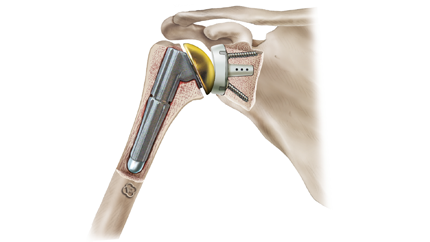- Have any questions?
- (+212) 0537-794-299
- (+212) 0537-282-805
- info@expertmedicalholding.com

SHOULDER

KNEE
27 octobre 2020
TARIC
27 octobre 2020
The healthy shoulder joint has the greatest range of motion among all joints in the human body. It enables movements and rotations in various directions. Without it we couldn’t use our arms and hands as effectively as we do. In order to allow this wide agility the shoulder is less constrained by surrounding bones in comparison to other joints. Instead muscles and tendons play an outstanding role. The shoulder is comprised of three slim bones: The upper arm (Humerus), the shoulder blade (Scapula) and the collarbone (Clavicle). The shoulder blade forms an oval articular cavity (Glenoid), which forms the articulating surface for the head of the upper arm.

Wear of the shoulder blade - osteoarthritis
Wear of the joint (osteoarthritis) means, that the cartilage is damaged and worn down. A smooth movement is not possible anymore and the patient is suffering from severe pain. Osteoarthritis in the shoulder is called omarthrosis. The ever increasing age alone is leading to wear - so called idiopathic arthrosis. Thus, to some extend degenerative cartilage is normal at a certain age. However, not everyone needs a joint replacement in life. Often omarthrosis occurs due to overstress or in combination with metabolic diseases, rheumatic diseases or infections that damage the cartilage. Usually the damage on the cartilage progresses slowly over many years. The cartilage is getting thinner and thinner, cracks occur and the formerly smooth surface frays and becomes rough. Painful inflammations and effusions are often the implications. Once the bone surface is not covered anymore and seamless motion is impossible patients start to suffer even without movement. Sometimes the body tries to compensate the damage by bone proliferation. This increases the contact surface, but does not solve the problem. Instead most of the times it increases the progression of the disease. Because usually only late stages cause severe pain conservative treatment options are often not effective anymore.

